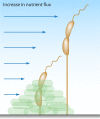Staying in Shape: the Impact of Cell Shape on Bacterial Survival in Diverse Environments
- PMID: 26864431
- PMCID: PMC4771367
- DOI: 10.1128/MMBR.00031-15
Staying in Shape: the Impact of Cell Shape on Bacterial Survival in Diverse Environments
Abstract
Bacteria display an abundance of cellular forms and can change shape during their life cycle. Many plausible models regarding the functional significance of cell morphology have emerged. A greater understanding of the genetic programs underpinning morphological variation in diverse bacterial groups, combined with assays of bacteria under conditions that mimic their varied natural environments, from flowing freshwater streams to diverse human body sites, provides new opportunities to probe the functional significance of cell shape. Here we explore shape diversity among bacteria, at the levels of cell geometry, size, and surface appendages (both placement and number), as it relates to survival in diverse environments. Cell shape in most bacteria is determined by the cell wall. A major challenge in this field has been deconvoluting the effects of differences in the chemical properties of the cell wall and the resulting cell shape perturbations on observed fitness changes. Still, such studies have begun to reveal the selective pressures that drive the diverse forms (or cell wall compositions) observed in mammalian pathogens and bacteria more generally, including efficient adherence to biotic and abiotic surfaces, survival under low-nutrient or stressful conditions, evasion of mammalian complement deposition, efficient dispersal through mucous barriers and tissues, and efficient nutrient acquisition.
Copyright © 2016, American Society for Microbiology. All Rights Reserved.
Figures





Similar articles
-
Induction of meningeal inflammation by diverse bacterial cell walls.Eur J Clin Microbiol. 1986 Dec;5(6):682-4. doi: 10.1007/BF02013304. Eur J Clin Microbiol. 1986. PMID: 3100293 No abstract available.
-
Bacterial Acclimation Inside an Aqueous Battery.PLoS One. 2015 Jun 12;10(6):e0129130. doi: 10.1371/journal.pone.0129130. eCollection 2015. PLoS One. 2015. PMID: 26070088 Free PMC article.
-
Carbohydrate recognition mechanisms which mediate microbial adherence to mammalian mucosal surfaces.Tokai J Exp Clin Med. 1982;7 Suppl:177-83. Tokai J Exp Clin Med. 1982. PMID: 6137090 No abstract available.
-
Spinning tails: homologies among bacterial flagellar systems.Trends Microbiol. 1996 Jun;4(6):226-31. doi: 10.1016/0966-842X(96)10037-8. Trends Microbiol. 1996. PMID: 8795158 Review.
-
Morphologies of Bacillus subtilis communities responding to environmental variation.Dev Growth Differ. 2017 Jun;59(5):369-378. doi: 10.1111/dgd.12383. Epub 2017 Jul 4. Dev Growth Differ. 2017. PMID: 28675458 Review.
Cited by
-
Synergistic phenotypic adaptations of motile purple sulphur bacteria Chromatium okenii during lake-to-laboratory domestication.PLoS One. 2024 Oct 22;19(10):e0310265. doi: 10.1371/journal.pone.0310265. eCollection 2024. PLoS One. 2024. PMID: 39436933 Free PMC article.
-
Innovative Biomedical and Technological Strategies for the Control of Bacterial Growth and Infections.Biomedicines. 2024 Jan 13;12(1):176. doi: 10.3390/biomedicines12010176. Biomedicines. 2024. PMID: 38255281 Free PMC article. Review.
-
The Transcriptional Regulator SpxA1 Influences the Morphology and Virulence of Listeria monocytogenes.Infect Immun. 2022 Oct 20;90(10):e0021122. doi: 10.1128/iai.00211-22. Epub 2022 Sep 14. Infect Immun. 2022. PMID: 36102657 Free PMC article.
-
Cytoskeletal organization in isolated plant cells under geometry control.Proc Natl Acad Sci U S A. 2020 Jul 21;117(29):17399-17408. doi: 10.1073/pnas.2003184117. Epub 2020 Jul 8. Proc Natl Acad Sci U S A. 2020. PMID: 32641513 Free PMC article.
-
Influences of Adhesion Variability on the "Living" Dynamics of Filamentous Bacteria in Microfluidic Channels.Molecules. 2016 Jul 28;21(8):985. doi: 10.3390/molecules21080985. Molecules. 2016. PMID: 27483214 Free PMC article.
References
Publication types
MeSH terms
Grants and funding
LinkOut - more resources
Full Text Sources
Other Literature Sources

